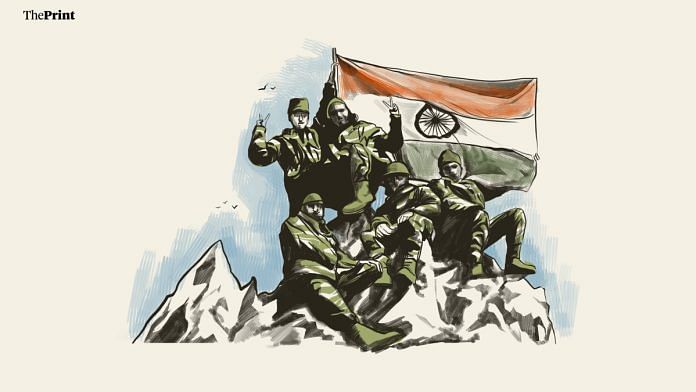Thank you dear subscribers, we are overwhelmed with your response.
Your Turn is a unique section from ThePrint featuring points of view from its subscribers. If you are a subscriber, have a point of view, please send it to us. If not, do subscribe here: https://theprint.in/subscribe/
(Continued from the First Part)
The Unacknowledged Cost: A Son’s Grief
Beyond the operational details, where was the depiction of the profound national impact and widespread outrage that followed the loss of IAF (flying) machines and Air Warriors? To my further shock, the martyrdom of Late Squadron Leader Ajay Ahuja, VrC, was barely acknowledged, dismissed in a mere couple of sentences. Squadron Leader Ahuja, a legend whose only son, Ankur, has been my friend since childhood, was our neighbour in Chennai. I distinctly recall weeping profusely when my mother shared the news of Ahuja Sir’s martyrdom, witnessing his image flash across national television.
Another poignant memory: I sat on the ground in the Officers’ Mess library in Agra, watching a lady read a newspaper. Its front page bore the haunting image of a six-year-old Ankur lighting his martyred father’s pyre. The sight of my young friend performing such an unimaginable rite left me profoundly shocked and numb.
The Overlooked Pioneers: First Eyes on the Intrusion
The documentary’s singular focus on the fighter fleet inflicted further damage. There was zero emphasis on the critical premise build-up—how the intrusions were initially detected, and how the IAF played a pivotal role in assessing the situation even before the war officially began. To this day, despite numerous online articles, there remains a baffling lack of awareness about Late Group Captain (Retd) Alagaraja Perumal and Group Captain (Retd) Uday Kant Jha. Technically, they were the first IAF pilots to discover the Pakistani intrusions in the Kargil sector, and their aircraft was even hit by a Stinger missile from Pakistani troops. My father recounted how he, along with many officers, rushed to Srinagar when their aircraft was hit, and the duo was kept under strict confinement after their emergency landing. Perumal was subsequently awarded the Shaurya Chakra, and Jha the Vayu Sena Medal. Yet, this documentary failed to project their bravery, their aircraft, and their foundational role in the war. It’s simply untenable to accept the excuse of “no permission” when so many articles on Perumal and Jha are publicly available online.
The makers, in their opening disclaimer, state that the film is based on information available in the public domain. If that’s the case, a quick Google search for “Perumal-Jha-Kargil” yields multiple websites and pages detailing their crucial narrative. Furthermore, the website Bharat Rakshak meticulously documents almost every unit involved in the Kargil War, including my father’s squadron.
Missing Perspectives: Army and Confrontation
The documentary’s limited perspective extends to its representation of the Indian Army, featuring only one officer, Lt. General (Retd) Yogesh Kumar Joshi. This singular focus creates a glaring omission of other vital figures, such as Brigadier (Retd) Khushal Thakur or Honorary Captain (Retd) Yogendra Singh Yadav from the 18 Grenadiers, both of whom were central to battles where the IAF played a critically pivotal role.
Another glaring omission: while Air Chief Marshal (Retd) Tipnis recounts his heated argument with former Army Chief General (Retd) Ved Prakash Malik, why was General Malik himself not interviewed? Capturing such a crucial confrontation would have been an invaluable element, imbuing the documentary with essential depth and perspective.
Geographical Blind Spots and Flawed Recreations
The documentary “blindly” focuses on just three air bases: Srinagar, Adampur, and Gwalior. While it briefly acknowledges Pathankot and Nal were on alert, it completely disregards the intense activity witnessed at Chandigarh and Agra bases. I experienced this firsthand as a seven-year-old at Air Force Station, Agra, seeing trucks transporting Bofors guns, Multi Barrel Rocket Launchers, and both active and martyred personnel.
The dramatic recreations also raise questions. The recently inducted IAF uniforms (seen in initial shots) felt anachronistic and out of place. And were all overalls truly green? I distinctly recall many Air Warriors, including my father, wearing blue and sometimes orange overalls during operations. Some staged portions appeared pretentious, failing to deliver the authentic portrayal I sought. And who, in professional circles, accurately refers to the Air Headquarters as “AIR HQ”?
A Resounding Call for Responsible Storytelling
As I conclude this passionate outpouring, I reflect on this documentary—partially redeemable, largely a profound missed opportunity. It serves as a stark reminder of how high-potential projects can falter, even in the pursuit of objectivity and facts, if they neglect balanced storytelling and genuine representation.
As the saying goes, history is created for future generations to learn from ‘mistakes.’ I earnestly hope that creators and artists will embrace this solemn responsibility, narrating stories with the depth, accuracy, and comprehensive insight they unequivocally deserve. This means avoiding egregious errors like director Siddharth Anand’s inexplicable depiction of an Assam-based fighter air base (Tezpur) as one in Srinagar in the film ‘Fighter’ (2024).
Epilogue: During my first year of college, a memorable evening unfolded at the Clarks Shiraz in Agra, where I had the fortune of sitting next to Gp Capt (Retd) Nachiketa as our families enjoyed dinner.
ABOUT THE AUTHOR: Boasting a diverse career spanning over a decade, Yash Mishra is a Delhi-based media freelancer. His experience includes significant contributions in various roles at Doordarshan and Peepul Tree World, as well as extensive work within the Indian film industry across multiple languages.
These pieces are being published as they have been received – they have not been edited/fact-checked by ThePrint.


